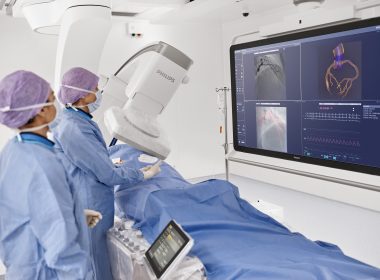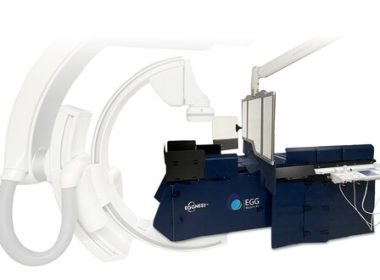Trial will evaluate the safety and effectiveness of the AtriCure Isolator® Synergy™ EnCompass® clamp and AtriClip® Left Atrial Appendage Exclusion System to reduce the occurrence of new-onset atrial fibrillation in cardiac surgery patients MASON, Ohio–(BUSINESS WIRE)–AtriCure, Inc. (Nasdaq: ATRC), a leading innovator in surgical treatments and therapies for atrial fibrillation (Afib), left atrial appendage […]
Coronary/Structural Heart
Edwards SAPIEN 3 TAVR Delivers Proven Long-term Benefits and Valve Performance, New Data Presented at TCT 2025
SAPIEN 3, which showed superiority at 1 year, also demonstrates compelling outcomes equivalent to surgery at seven years SAN FRANCISCO–(BUSINESS WIRE)–Edwards Lifesciences (NYSE: EW) today announced seven-year data from the PARTNER 3 trial, reaffirming the early and sustained patient benefits of Edwards TAVR. The data, which showed superior clinical outcomes […]
Cardiosense Presents New Clinical Analysis of SEISMIC-HF I Data on AI-Enabled Volume Assessment in Heart Failure at the Transcatheter Cardiovascular Therapeutics (TCT) 2025 Scientific Symposium
CHICAGO–(BUSINESS WIRE)–Cardiosense, a digital health company pioneering AI-enabled solutions for cardiac disease management, today announced a new subgroup analysis of clinical data from the SEISMIC-HF I study at the Cardiovascular Research Foundation’s 2025 annual Transcatheter Cardiovascular Therapeutics® (TCT®) scientific symposium. The analysis examined the prescribed medications for symptomatic patients hospitalized with […]
Anteris Technologies Announces First Patients Treated in DurAVR® THV Global Pivotal Trial (the “PARADIGM Trial”)
MINNEAPOLIS, United States and BRISBANE, Australia, Oct. 27, 2025 (GLOBE NEWSWIRE) — Anteris Technologies Global Corp. (Anteris or the Company) (NASDAQ: AVR, ASX: AVR) a global structural heart company committed to designing, developing, and commercializing cutting-edge medical devices to restore healthy heart function, today announced the first patients have been enrolled and successfully treated in the DurAVR® Transcatheter Heart Valve (THV) global pivotal trial for patients with severe calcific aortic stenosis (the “PARADIGM Trial”). The procedures were performed by Prof. Dr. Ole De Backer at, The Heart Center, Rigshospitalet, Copenhagen University Hospital, Copenhagen, Denmark. “We are proud to be the first enrolling center for this important trial,“ said Prof. Dr. De Backer. “Our initial experience with the DurAVR® THV System has been very positive, and we look forward to providing definitive comparative evidence which could transform patient care.” “With the first patients now randomized in the PARADIGM Trial, we are actively generating the clinical evidence required to advance the DurAVR® THV toward commercialisation, expanding treatment options for aortic stenosis patients,” said Anteris Chief Medical Officer, Chris Meduri, M.D. “This head-to-head study will provide robust comparative evidence across all surgical risk groups, which we believe will differentiate our platform based on efficacy, safety and ease of use.” The PARADIGM Trial builds on Anteris’ existing clinical data set of 130 patients successfully treated with the DurAVR® THV, including de novo (first time) aortic stenosis cases, valve-in-valve (ViV) patients and complex anatomies such as bicuspid aortic valve patients. Anteris aims to drive the global PARADIGM Trial through the addition of further countries and sites in the near term, with planned expansion across the United States, Europe and Canada. Management believes strong enthusiasm from investigators is expected to translate into efficient recruitment and timely study advancement. About the PARADIGM Trial The PARADIGM Trial is a prospective randomized controlled trial* (RCT) which will evaluate the safety and effectiveness of the DurAVR® THV compared to commercially available transcatheter aortic valve replacements (TAVRs). This head-to-head study will enroll approximately 1,000 patients in the ‘All Comers Randomized Cohort’ with 1:1 randomization of patients who will receive either the DurAVR® THV or TAVR using commercially available and approved THVs. The PARADIGM Trial will assess non-inferiority on a primary composite endpoint of all-cause mortality, all stroke and cardiovascular hospitalization at one year post procedure. For further information, please refer to ClinicalTrials.gov (ClinicaTrials.gov ID NCT07194265). The planned expansion across other geographies includes additional cohorts. *A Premarket Approval (PMA) application requires a high level of clinical evidence to demonstrate reasonable assurance of safety and effectiveness for the intended use. Randomized controlled trials are generally considered Level 1 evidence, the highest level for determining the effectiveness of interventions in evidence-based medicine given RCTs mimimize bias and allow a clear comparison between treatment groups. About Anteris Anteris Technologies Global Corp. (NASDAQ: AVR, ASX: AVR) is a global structural heart company committed to designing, developing, and commercializing cutting-edge medical devices to restore healthy heart function. Founded in Australia, with a significant presence in Minneapolis, USA, Anteris is a science-driven company with an experienced team of multidisciplinary professionals delivering restorative solutions to structural heart disease patients. Anteris’ lead product, the DurAVR® Transcatheter Heart Valve (THV), was designed in partnership with the world’s leading interventional cardiologists and cardiac surgeons to treat aortic stenosis – a potentially life-threatening condition resulting from the narrowing of the aortic valve. The balloon-expandable DurAVR® THV is the first biomimetic valve, which is shaped to mimic the performance of a healthy human aortic valve and aims to replicate normal aortic blood flow. DurAVR® THV is made using a single piece of molded ADAPT® tissue, Anteris’ patented anti-calcification tissue technology. ADAPT® tissue, which is FDA-cleared, has been used clinically for over 10 years and distributed for use in over 55,000 patients worldwide. The DurAVR® THV System is comprised of the DurAVR® valve, the ADAPT® tissue, and the balloon-expandable ComASUR® Delivery System. Forward-Looking Statements This announcement contains forward-looking statements, including statements regarding the planned expansion of the PARADIGM Trial, the results of the PARADIGM Trial, the quotes from Prof. Dr. De Backer and Chris Meduri, M.D., the contours of the PARADIGM Trial, and the expansion of the PARADIGM trial to other countries and cohorts. Forward-looking statements include all statements that are not historical facts. Forward-looking statements generally are identified by the words “believe,” “project,” “expect,” “anticipate,” “estimate,” “intend,” “budget,” “target,” “aim,” “strategy,” “plan,” “guidance,” “outlook,” “may,” “should,” “could,” “will,” “would,” “will be,” “will continue,” “will likely result” and similar expressions, although not all forward-looking statements contain these identifying words. These forward-looking statements are subject to a number of risks, uncertainties, and assumptions, including those described under “Risk Factors” in Anteris’ Annual Report on Form 10-K for the fiscal period ended December 31, 2024 that was filed with the SEC and ASX. Readers are cautioned not to put undue reliance on forward-looking statements, and except as required by law, Anteris does not assume any obligation to update any of these forward-looking statements to conform these statements to actual results or revised expectations. For more information: Investor Relations Investor Relations (US)investor@anteristech.com mchatterjee@bplifescience.comDebbie Ormsby Malini Chatterjee, Ph.D.Anteris Technologies Global Corp. Blueprint Life Science Group+61 1300 550 310 | +61 7 3152 3200 +1 917 330 4269 Website www.anteristech.com X @AnterisTech LinkedIn https://www.linkedin.com/company/anteristech
Elixir Medical Announces Significant Late Breaking Clinical Results for DynamX® Bioadaptor Demonstrating Nearly 50% Reduction in Coronary Event Rates vs. Current PCI Standard of Care
Results were presented at the Transcatheter Cardiovascular Therapeutics (TCT) Conference 2025 in San Francisco on October 27, 2025 DynamX® bioadaptor is the first interventional technology to demonstrate significant benefit with a reduction in long term adverse events in two consecutive randomized controlled trials MILPITAS, Calif., Oct. 27, 2025 (GLOBE NEWSWIRE) — Elixir Medical, a developer of disruptive technologies to treat cardiovascular disease, today announced new landmark clinical results for its DynamX® bioadaptor, a coronary implant designed to restore a blood vessel’s natural movement and function, also known as hemodynamic modulation, demonstrating a 48% risk reduction in device-related cardiac events compared to current-generation drug-eluting stent. The findings, presented on October 27th at the Transcatheter Cardiovascular Therapeutics (TCT) Conference 2025 in San Francisco, mark a major advance in coronary interventions after two decades of attempts to improve stenting outcomes. The results show that the DynamX® bioadaptor achieved a 48% reduction in Target Lesion Failure (TLF) endpoint – encompassing reductions in cardiac death, target vessel myocardial infarction, and ischemia-driven target lesion revascularization – from six months through two years (HR: 0.52 [0.29–0.93], p=0.027) in prespecified landmark superiority analysis. Additional findings include: Significant reduction in Target Vessel Failure (TVF) (p=0.048) from six months through two years in prespecified landmark analysis.Substantial clinical benefit for high-risk patients with Acute Coronary Syndrome (ACS) (p=0.018) from six months through two years in prespecified landmark analysis. “The INFINITY-SWEDEHEART long-term landmark results confirm our trial design hypothesis, demonstrating separation of the event curves for Target Lesion Failure (TLF) at six months and maintaining consistency up to two years with a reduction of TLF by 48%. Our data validates the unique property of the bioadaptor of restoring coronary physiology after unlocking after half a year, which translates into improved clinical outcomes long-term,” said Principal Investigator David Erlinge, M.D., Ph.D., Head of the Cardiology Department at Lund University, Lund, Sweden. The TCT presentation comes amid renewed global focus on rethinking coronary artery disease management. The recent Lancet Commission on rethinking coronary disease called for a paradigm shift from symptom-based treatment to earlier prevention and intervention, citing that cardiovascular disease affects roughly 19% of the global population and remains the world’s leading cause of death. In addition to delivering the DynamX® bioadaptor’s impressive results, presentations from multiple leading physicians investigating and demonstrating successful clinical outcomes with Elixir Medical technologies garnered a heavy podium presence each day at the TCT Conference. From October 25th through the 28th, investigators are unveiling new clinical and case performance data regarding the company’s LithiX™ Hertz Contact Intravascular Lithotripsy (HC-IVL) device while leading the discussion on topics like Is It Time to Move Beyond Stents for Lasting Patient Outcomes? and The Rebirth of Novel Technologies for Coronary PCI. As highlighted in a recent Wall Street Journal piece on physicians’ efforts to improve coronary artery disease treatment, in-stent restenosis and thrombosis after angioplasty (PCI) continue to drive repeat interventions and adverse outcomes despite widespread use of drug-eluting stents, adding to worsening long-term patient prognosis and significant healthcare costs. The DynamX® bioadaptor directly addresses these stent related issues by unlocking, adapting, and allowing the artery to heal and return to natural motion after fixated support is no longer needed: a key limitation of drug-eluting stents. About DynamX® Coronary Bioadaptor System The DynamX® bioadaptor is the first coronary implant technology designed to restore coronary artery hemodynamic modulation as demonstrated by restored vessel pulsatility, compliance, and adaptive increase in blood flow volume, and reduction in plaque progression. With its unique mechanism of action (MOA), it addresses the shortcomings of drug-eluting stents and bioresorbable scaffolds (BRS) with remarkably low clinical event rates that showed a plateau from six months through three-year clinical follow-up in BIOADAPTOR-RCT trial. The DynamX® Sirolimus Eluting Coronary Bioadaptor System is an investigational device in the United States limited by United States law to investigational use. The DynamX® Coronary Bioadaptor System is CE-mark approved. About Elixir Medical Elixir Medical Corporation, a privately held company based in Milpitas, California, develops disruptive platforms to treat coronary and peripheral artery disease. Our transformative technologies have multiple applications across the cardiovascular space capable of delivering improved clinical outcomes for millions of patients. Elixir Medical was named to Fast Company’s prestigious list of the World’s Most Innovative Companies of 2025 and Fierce Medtech’s 2025 Fierce 15 list. Visit us at www.elixirmedical.com and on LinkedIn and X. Media Contact Richard LaermerRLM PRelixir@rlmpr.com(212) 741-5106 X 216
Philips introduces industry-first cath lab integration that automatically synchronizes pre-operative CT with C-arm movement, paving the way for CT-guided PCI
Philips Follow C-arm capability
Follow C-arm
October 27, 2025 New integration of Philips Advanced Visualization Workspace* with the Azurion image-guided therapy platform automatically synchronizes CT images with C-arm movement, supporting workflow efficiency and additional anatomical insights in PCI procedures1 San Francisco, USA and Amsterdam, The Netherlands – At the annual Transcatheter Cardiovascular Therapeutics (TCT 2025) meeting, Royal Philips (NYSE: PHG, AEX: PHIA), a global leader in health technology, today introduced an industry-first innovation that integrates pre-operative CT data directly into the cath lab workflow. This new capability, available through the integration of Philips’ Advanced Visualization Workspace (AVW) with the Azurion image-guided therapy system, marks a first step towards CT-guided percutaneous coronary intervention (PCI), a minimally invasive procedure to open narrowed coronary arteries and restore blood flow to the heart.The new capability, Follow C-arm, automatically synchronizes the 3D reconstruction of coronary arteries with the movement of the Azurion C-arm. As the C-arm angulation changes, the CT volume rotates in real time to match, giving interventionalists the 3D anatomical view without manual interaction. This seamless connection helps clinicians combine the detailed insights of CT imaging with the flexibility of live X-ray guidance inside the cath lab. The combined AVW–Azurion approach aims to provide enhanced anatomical insights to guide complex PCI procedures, publications have shown that leveraging CCTA may lead to reduction in contrast medium use and radiation dose during interventions.1Supporting the shift towards CT-guided PCICoronary computed tomography angiography (CCTA) is increasingly used in global clinical guidelines as a first-line tool for the diagnosis and planning of coronary artery disease. With more patients now arriving at the cath lab with prior CT scans, physicians are seeking ways to incorporate this information into their interventional workflows. By integrating CT data directly into Azurion, Philips is helping interventionalists expand the use of CT beyond diagnosis and planning, supporting a future in which CT-guided PCI becomes standard practice.“By bringing pre-operative CT into the cath lab and linking it directly to the movement of the C-arm, Philips is delivering an industry-first that helps interventionalists prepare for and execute PCI procedures with greater confidence,” said Mark Stoffels, Business Leader Image-Guided Therapy Systems at Philips. “This seamless integration is a significant step towards CT-guided PCI, aligning with our commitment to improving workflow efficiency and advancing patient care in interventional cardiology.”The launch builds on the global success of Philips’ Azurion image-guided therapy platform, the world’s leading system designed for seamless integration of advanced applications. Since its introduction in 2017, Azurion has been used to treat more than 6.4 million patients annually in over 80 countries, helping physicians perform minimally invasive procedures with greater confidence and efficiency.For more information about Philips’ presence at TCT, please visit the Philips TCT 2025 landing page. For further information, please contact:Joost MalthaPhilips Global External RelationsTel.: +31 6 1055816E-mail: joost.maltha@philips.com About Royal Philips Royal Philips (NYSE: PHG, AEX: PHIA) is a leading health technology company focused on improving people’s health and well-being through meaningful innovation. Philips’ patient- and people-centric innovation leverages advanced technology and deep clinical and consumer insights to deliver personal health solutions for consumers and professional health solutions for healthcare providers and their patients in the hospital and the home.Headquartered in the Netherlands, the company is a leader in diagnostic imaging, ultrasound, image-guided therapy, monitoring and enterprise informatics, as well as in personal health. Philips generated 2024 sales of EUR 18 billion and employs approximately 67,800 employees with sales and services in more than 100 countries. News about Philips can be found at www.philips.com/newscenter. Disclaimer: * The Follow C-arm capability as part of Philips Advanced Visualization Workspace may not be available in all markets. Please contact your Philips representative for more details.Reference: 1. J Cardiovasc Comput Tomogr. 2025 May-Jun;19(3):277-290.
Attachments
Philips Follow C-arm capability
Follow C-arm
Orchestra BioMed Announces First Patients Enrolled in Virtue® SAB US Pivotal IDE Coronary Trial
Orchestra BioMed’s Virtue® Sirolimus AngioInfusionTM Balloon (“Virtue SAB”) is the first non-coated drug-eluting balloon system designed to deliver a large liquid dose of proprietary extended-release sirolimus (“SirolimusEFRTM”)The Virtue Trial is the first U.S. investigational device exemption (“IDE”) head-to-head randomized coronary pivotal trial evaluating a sirolimus-eluting balloon versus a commercially available paclitaxel-coated balloon (AGENT™) Coronary in-stent restenosis (“ISR”), the clinical focus of the Virtue Trial, is a difficult-to-treat and serious complication of coronary stenting that increases the risk of life-threatening heart problems, affecting an estimated 100,000 patients in the U.S. annuallyVirtue SAB has FDA Breakthrough Device Designation for the treatment of coronary ISR, as well as for coronary small vessel disease and below-the-knee peripheral artery disease NEW HOPE, Pa., Oct. 27, 2025 (GLOBE NEWSWIRE) — Orchestra BioMed Holdings, Inc. (Nasdaq: OBIO, “Orchestra BioMed” or the “Company”), a biomedical company accelerating high-impact technologies to patients through strategic partnerships with market-leading global medical device companies, today announced the first patient enrollments in the Virtue SAB in the Treatment of Coronary ISR Trial (“Virtue Trial”), the Company’s U.S. IDE pivotal trial comparing its highly differentiated Virtue® Sirolimus AngioInfusionTM Balloon (“Virtue SAB”) to the AGENT paclitaxel-coated balloon, currently the only drug-coated balloon (“DCB”) FDA-approved for a coronary indication. The initial cases were successfully completed by the teams at The Christ Hospital Heart & Vascular Institute in Cincinnati, OH, and St. Francis Hospital & Heart Center in Roslyn, NY, marking the initiation of the Virtue Trial. Dean J. Kereiakes, M.D., FACC, MSCAI, Chairman of The Christ Hospital Heart & Vascular Institute and Medical Director of The Christ Hospital Research Institute and Allen Jeremias M.D., Director of Interventional Cardiology Research and Associate Director, Cardiac Catheterization Laboratory, St. Francis Hospital & Heart Center are co-principial investigators of the Virtue Trial. Designed to support regulatory approval of Virtue SAB, the Virtue Trial is expected to enroll 740 patients at up to 75 centers in the United States with enrollment completion currently planned for mid-2027. Virtue SAB: Redefining Delivery of Sirolimus “Virtue SAB and SirolimusEFR were specifically designed to optimize the dose, delivery, uptake and extended release of sirolimus without the limitations of a drug coating on the balloon surface. A substantial body of clinical evidence from drug-eluting stent studies has established sirolimus and its analogs as the gold-standard drug for promoting vessel healing and preventing restenosis following interventional procedures,” said Jarrod D. Frizzell, MD, MS, FACC, FSCAI, Director of Complex Coronary Therapeutics, Interventional Cardiology, The Christ Hospital Health Network. “The Virtue Trial will allow us to evaluate the performance of this fundamentally different approach to delivering sirolimus, which has shown promising results in a prior pilot clinical study in coronary ISR treatment, in direct comparison to the AGENT paclitaxel-coated balloon.” Additionally, Dr. Jeremias commented, “Drug coated balloons offer a promising alternative to drug-eluting stents for the treatment of coronary indications such as coronary ISR. Virtue SAB and SirolimusEFR are designed to go beyond DCBs with the goal of optimizing drug dosing, tissue uptake and extended drug bioavailability at the site of treatment. Our team at St. Francis is excited to play a leadership role in the Virtue Trial which will evaluate this differentiated, non-coated drug-delivery system head-to-head versus the current market leading DCB.” Virtue SAB is designed to deliver a large liquid dose of a proprietary extended-release formulation of sirolimus, SirolimusEFR™, through a non-coated microporous AngioInfusion™ Balloon that protects the drug in transit and helps overcome certain limitations of DCBs. SirolimusEFR™ is designed to enable enhanced tissue uptake and extended release of therapeutic levels of sirolimus through the critical healing period, exceeding previously published target tissue concentrations of proven drug-eluting stents. In the multi-center SABRE pilot study, Virtue SAB demonstrated promising clinical results for the treatment of single-layer coronary ISR: 12-month target lesion failure of 2.8%Zero target lesion revascularizations from 12-month follow-up through 36-month follow-up; and6-month late lumen loss of 0.12mm. Virtue SAB has FDA Breakthrough Device Designation for the treatment of coronary ISR, as well as for coronary small vessel disease and below-the-knee peripheral artery disease. Orchestra BioMed estimates the total global market opportunity for drug-eluting balloons to be over $10 billion annually. A Head-to-Head Randomized Evaluation of a Sirolimus-Eluting Balloon vs. a Paclitaxel-Coated BalloonThe Virtue Trial is a prospective, multi-center, randomized trial comparing clinical outcomes of Virtue SAB to AGENT Paclitaxel DCB in the treatment of coronary ISR. Data from the Virtue Trial is expected to be used to support regulatory approval in the U.S. The primary endpoint is a non-inferiority comparison of Target Lesion Failure (TLF) defined as a composite of cardiac death, nonfatal target vessel myocardial infarction and ischemia-driven target lesion revascularization at 12 months. The trial is expected to randomize 740 patients across up to 75 centers in the U.S. Darren R. Sherman, President and Chief Operating Officer of Orchestra BioMed stated, “We believe the future of arterial disease treatment will be driven by optimized delivery and extended tissue release of therapeutic doses of sirolimus, the proven antiproliferative drug with well-established safety and effectiveness. Balloon surface-coating drug delivery has challenges and limitations, including dosing constraints, drug-loss that requires rapid device navigation, and the release of large embolic particulates. We designed Virtue SAB and its key enabling technology, our proprietary SirolimusEFR, to overcome these limitations and realize the full potential of arterial drug delivery during angioplasty. With the launch of the Virtue Trial, we’re taking a major step toward realizing our vision of improving patient outcomes.” About Coronary In-Stent Restenosis (ISR)Coronary ISR is a serious complication of coronary stenting, which can increase the risk of life-threatening heart problems. It is characterized by re-narrowing of a coronary artery segment that was previously treated with a stent. According to the National Cardiovascular Data Registry, coronary ISR occurs in up to 10% of stented patients during the first year and continues at a rate of up to 3% per year thereafter, resulting in an estimated over 325,000 coronary ISR lesions annually worldwide that may require treatment. If left untreated, coronary ISR may lead to stable angina, unstable angina, acute coronary syndrome, acute myocardial infarction, or death. About Virtue SABVirtue SAB is a highly differentiated, first-of-its-kind drug delivery angioplasty balloon system designed to deliver a proprietary extended-release formulation of sirolimus, SirolimusEFR™. It uses a patented non-coated microporous AngioInfusion™ Balloon to protect the drug in transit and consistently deliver a large liquid dose, overcoming certain limitations of drug-coated balloons. SirolimusEFR delivered by Virtue SAB has been shown in published preclinical series involving hundreds of arterial deliveries to achieve therapeutic levels of extended-release sirolimus through the critical healing period, exceeding published target tissue concentration of proven drug-eluting stents. Virtue SAB and SirolimusEFR demonstrated positive three-year clinical data in coronary ISR in the SABRE study, a multi-center, prospective, independent core lab-adjudicated clinical study of 50 patients conducted in Europe. Virtue SAB has been granted Breakthrough Device Designation by the FDA for the treatment of coronary ISR, coronary small vessel disease and below-the-knee peripheral artery disease. About Orchestra BioMed Orchestra BioMed is a biomedical innovation company accelerating high-impact technologies to patients through strategic collaborations with market-leading global medical device companies. The Company’s two flagship product candidates – Atrioventricular Interval Modulation (AVIM) Therapy and Virtue® Sirolimus AngioInfusionTM Balloon (Virtue SAB) – are currently undergoing pivotal clinical trials for their lead indications, each representing multi-billion-dollar annual global market opportunities. AVIM Therapy is a bioelectronic treatment for hypertension, the leading risk factor for death worldwide, and is designed to be delivered as a firmware upgrade to a pacemaker and achieve immediate, substantial and sustained reductions in blood pressure in patients with hypertensive heart disease. The Company has a strategic collaboration with Medtronic (NYSE: MDT), one of the largest medical device companies in the world, for the development and commercialization of AVIM Therapy for the treatment of uncontrolled hypertension in pacemaker-indicated patients. AVIM Therapy has FDA Breakthrough Device Designation for these patients, as well as an estimated 7.7 million total patients in the U.S. with uncontrolled hypertension despite medical therapy and increased cardiovascular risk. Virtue SAB is a highly differentiated, first-of-its-kind drug delivery angioplasty balloon system designed to deliver a proprietary extended-release formulation of sirolimus, SirolimusEFR™, for the treatment of atherosclerotic artery disease, the leading cause of mortality worldwide. Virtue SAB has been granted Breakthrough Device Designation by the FDA for the treatment of coronary ISR, coronary small vessel disease and below-the-knee peripheral artery disease. For further information about Orchestra BioMed, please visit www.orchestrabiomed.com, and follow us on LinkedIn. References to Websites and Social Media Platforms References to information included on, or accessible through, websites and social media platforms do not constitute incorporation by reference of the information contained at or available through such websites or social media platforms, and you should not consider such information to be part of this press release. Forward-Looking Statements Certain statements included in this press release that are not historical facts are forward-looking statements for purposes of the safe harbor provisions under the United States Private Securities Litigation Reform Act of 1995. Forward-looking statements generally are accompanied by words such as “believe,” “may,” “will,” “estimate,” “continue,” “anticipate,” “intend,” “expect,” “should,” “would,” “plan,” “predict,” “potential,” “seem,” “seek,” “future,” “outlook” and similar expressions that predict or indicate future events or trends or that are not statements of historical matters. These forward-looking statements include, but are not limited to, statements relating to the enrollment, timing, implementation and design of the Virtue Trial, the ability of data from the Virtue Trial to support regulatory approval in the U.S., the potential efficacy and safety of the Company’s commercial product candidates, the ability of the Company’s partnerships to accelerate clinical development, and the Company’s late-stage development programs, strategic partnerships and plans to expand its product pipeline. These statements are based on various assumptions, whether or not identified in this press release, and on the current expectations of the Company’s management and are not predictions of actual performance. These forward-looking statements are provided for illustrative purposes only and are not intended to serve as and must not be relied on as a guarantee, an assurance, a prediction, or a definitive statement of fact or probability. Actual events and circumstances are difficult or impossible to predict and may differ from assumptions. Many actual events and circumstances are beyond the control of the Company. These forward-looking statements are subject to a number of risks and uncertainties, including changes in domestic and foreign business, market, financial, political, and legal conditions; failure to realize the anticipated benefits of the business combination; risks related to regulatory approval of the Company’s product candidates; the timing of, and the Company’s ability to achieve, expected regulatory and business milestones; the impact of competitive products and product candidates; and the risk factors discussed under the heading “Item 1A. Risk Factors” in the Company’s Annual Report on Form 10-K for the year ended December 31, 2024, which was filed with the Securities and Exchange Commission (the “SEC”) on March 31, 2025, and the risk factor discussed under the heading “Item 1A. Risk Factors” in the Company’s Quarterly Report on Form 10-Q for the quarterly period ended March 31, 2025, which was filed with the SEC on May 12, 2025, as updated by any risk factors disclosed under the heading “Item 1A. Risk Factors” in the Company’s subsequently filed quarterly reports on Form 10-Q. The Company operates in a very competitive and rapidly changing environment. New risks emerge from time to time. Given these risks and uncertainties, the Company cautions against placing undue reliance on these forward-looking statements, which only speak as of the date of this press release. The Company does not plan and undertakes no obligation to update any of the forward-looking statements made herein, except as required by law. Investor Contact:Silas NewcombOrchestra BioMedSnewcomb@orchestrabiomed.com Media Contact:Kelsey Kirk-EllisOrchestra BioMedKkirkellis@orchestrabiomed.com
Medera Announces First Patient Dosed in Phase 2 Portion of MUSIC-HFrEF Phase 1b/2 Trial Evaluating SRD-001 Gene Therapy for Heart Failure with Reduced Ejection Fraction
BOSTON, Oct. 27, 2025 (GLOBE NEWSWIRE) — Medera Inc. (“Medera”), a clinical-stage biopharmaceutical company focused on targeting cardiovascular diseases by developing next-generation therapeutics, today announced that the first patient has been dosed in the Phase 2 portion of the MUSIC-HFrEF Phase 1b/2 clinical trial evaluating the gene therapy candidate SRD-001 in patients with heart failure with reduced ejection fraction (HFrEF). The patient was successfully treated on September 5, 2025, and additional patients are scheduled for treatment. HFrEF is a prevalent form of heart disease that accounts for half of an estimated 64.3 million heart failure cases worldwide and is currently considered a mass market incurable disease. The Phase 2 portion is a randomized, double-blind, placebo-controlled study with a 1:1 randomization (placebo versus 4.5x1013vg injected dose per patient) and a total sample size of 50 patients to further evaluate the efficacy and safety of SRD-001 in a larger patient population. The initiation of Phase 2 follows the independent Data and Safety Monitoring Board’s (DSMB) recommendation in March 2025 to advance the trial based on its review of data from all nine patients in the Phase 1b portion. The patient was treated using Medera’s proprietary minimally invasive intracoronary infusion methodology and tolerated the procedure well. “The initiation of the placebo-controlled Phase 2 portion marks an important step forward in evaluating the efficacy and safety of SRD-001 in a larger patient population with advanced heart failure,” said Brian Jaski, M.D., Principal Investigator of MUSIC-HFrEF and Scientific Director of Research at the San Diego Cardiac Center. “We are encouraged by the progress of this cardiac gene therapy trial for patients with heart failure with reduced ejection fraction.” “We are pleased to announce this important milestone for the MUSIC-HFrEF program,” said Ronald Li, Ph.D., CEO and co-founder of Medera. “The Phase 2 portion will further evaluate SRD-001 and advance our clinical program as we work toward developing next-generation therapeutics for HFrEF patients.” For more information on the MUSIC-HFrEF trial, please visit clinicaltrials.gov/study/NCT04703842. About SRD-001 SRD-001 is an investigational gene therapy candidate that contains an adeno-associated virus serotype 1 (AAV1) vector expressing the transgene for sarco(endo)plasmic reticulum Ca2+ ATPase 2a isoform (SERCA2a), in anti-AAV1 neutralizing antibody (NAb) negative subjects with ischemic or non-ischemic cardiomyopathy and New York Heart Association (NYHA) class III/IV symptoms of heart failure with reduced ejection fraction (HFrEF). About Heart Failure with reduced Ejection Fraction (HFrEF) HFrEF is a complex cardiovascular pathophysiological syndrome that impairs normal cardiac function and results in the inability of the heart to pump a sufficient supply of blood to meet the body demand. Once established, HFrEF is generally progressive, irreversible, associated with debilitating symptoms, frequent re-hospitalizations and high mortality rates. An urgent need exists for disease modifying therapies, such as SRD-001, which aim to reverse the pathophysiology of HFrEF. About Medera Inc. Medera is a clinical-stage biopharmaceutical company focused on targeting difficult-to-treat and currently incurable diseases by developing a range of next-generation therapeutics. Medera operates via its two preclinical and clinical business units, Novoheart and Sardocor, respectively. Novoheart capitalizes on the world’s first and award-winning “mini-Heart” Technology for revolutionary disease modelling and drug discovery, uniquely enabling the modelling of human-specific diseases and discovery of therapeutic candidates free from species-specific differences in accordance to the FDA Modernization Act 2.0. Novoheart’s versatile technology platform provides a range of state-of-the-art automation hardware and software as well as screening services, for human-specific disease modelling, therapeutic target discovery and validation, drug toxicity and efficacy screening, and dosage optimization carried out in the context of healthy and/or diseased human heart chambers and tissues. Global pharmaceutical and academic leaders are using Novoheart’s technology platform for their drug discovery and development purposes. The Novoheart platform has facilitated and accelerated the development of Sardocor’s lead therapeutic candidates that are currently in clinical trials. Sardocor is dedicated to the clinical development of novel next-generation therapies for Medera. Leveraging Novoheart’s human-based drug discovery and validation platforms, Sardocor aims to expedite drug development and regulatory timelines for its gene and cell therapy pipeline. Sardocor has received Investigational New Drug (IND) clearances from the FDA for three ongoing AAV-based cardiac gene therapy clinical trials targeting Heart Failure with Reduced Ejection Fraction (HFrEF), Heart Failure with Preserved Ejection Fraction (HFpEF) with the Fast Track Designation, and Duchenne Muscular Dystrophy-associated Cardiomyopathy (DMD-CM) with the Orphan Drug Designation. Additionally, Sardocor’s pipeline includes four preclinical gene therapy and three preclinical small molecule candidates targeting various cardiac, pulmonary, and vascular diseases. For more information, please visit www.medera.bio. Contacts Ally StubinPublic RelationsICR HealthcareAlly.stubin@icrhealthcare.com 646.667.1861 Stephanie CarringtonInvestor RelationsICR HealthcareStephanie.carrington@icrhealthcare.com 646.277.1282
Cordis Unveiled Breakthrough Results from SELUTION DeNovo and SELUTION4ISR Randomized Trials at TCT 2025, Transforming Coronary Artery Disease (CAD) Treatment Beyond Stenting
SELUTION DeNovo Trial – the largest randomized Drug Eluting Balloon trial – demonstrates a SELUTION SLR™ DEB strategy is non-inferior to a Drug Eluting Stent treatment strategy in de novo lesions. SELUTION4ISR, a randomized controlled trial, proves SELUTION SLR™ DEB is an alternative to…
Real-World Data Presented at TCT 2025 Demonstrates the EggNest™ Complete Radiation Protection System Significantly Reduces Radiation Exposure for the Entire Cath Lab Team
SAN FRANCISCO, Oct. 26, 2025 /PRNewswire/ — At the 2025 Transcatheter Cardiovascular Therapeutics® (TCT) Conference, Dr. Jarrod Frizzell of The Christ Hospital (Cincinnati, OH) presented real-world studies¹,² demonstrating that the EggNest™ Complete Radiation Protection System from Egg…












